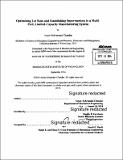| dc.contributor.advisor | Stanley B. Gershwin. | en_US |
| dc.contributor.author | Chandar, Arjun Subramani | en_US |
| dc.contributor.other | Massachusetts Institute of Technology. Department of Mechanical Engineering. | en_US |
| dc.date.accessioned | 2015-02-05T18:28:12Z | |
| dc.date.available | 2015-02-05T18:28:12Z | |
| dc.date.copyright | 2014 | en_US |
| dc.date.issued | 2014 | en_US |
| dc.identifier.uri | http://hdl.handle.net/1721.1/93842 | |
| dc.description | Thesis: M. Eng. in Manufacturing, Massachusetts Institute of Technology, Department of Mechanical Engineering, 2014. | en_US |
| dc.description | Cataloged from PDF version of thesis. | en_US |
| dc.description | Includes bibliographical references (pages 83-84). | en_US |
| dc.description.abstract | This thesis addresses the value of optimizing lot sizing to meet part demand within the limits of machine capacity, focusing on a method for improving productivity within the CNC turning and CNC milling departments at the Waters Corporation Machining Center in Milford, Massachusetts. A detailed study of the machining center revealed problems with low machine utilization in turning and milling, low on-time delivery performance and a need for day-to-day adjustments to the production schedule. These problems were attributed to inefficient data collection and use of data, poor production scheduling, and lot sizing that the system's capacity could not handle, causing frequent occurrence of redundant part setups and enabling delays in turning and milling which cascaded to downstream processes. This thesis addresses the latter problem by implementing optimized lot sizing for ten selected part types going through the turning and milling departments; the system design called for increases to the lot sizes of five of these part types. In order to prevent increased lot sizes from causing unforeseen problems in downstream processes, the project further implemented a supermarket for these selected parts at the end of milling operations, in order to decouple turning and milling from other processes. The lot sizing methodology focused on parts going through a turning operation followed by a milling one, with selected part types being machined on one of two machines in each department. In order to limit increases to work-in-progress inventory caused by increased lot sizes, the supermarket was designed to be managed by a Kanban-based pull system using a modified (Q, R) inventory policy with an expected weekly service level of 95%. Over the course of the implementation period, the lot sizing methodology saved an estimated 36.75 hours of setup time for parts made in 407.25 productive hours of run time. Moreover, a simulation over a year-long period estimates that with the new lot sizes, the machines in question will achieve an aggregated increase in productive hours of nearly 10%. | en_US |
| dc.description.statementofresponsibility | by Arjun Subramani Chandar. | en_US |
| dc.format.extent | 89 pages | en_US |
| dc.language.iso | eng | en_US |
| dc.publisher | Massachusetts Institute of Technology | en_US |
| dc.rights | M.I.T. theses are protected by copyright. They may be viewed from this source for any purpose, but reproduction or distribution in any format is prohibited without written permission. See provided URL for inquiries about permission. | en_US |
| dc.rights.uri | http://dspace.mit.edu/handle/1721.1/7582 | en_US |
| dc.subject | Mechanical Engineering. | en_US |
| dc.title | Optimizing lot sizes and establishing supermarkets in a multi-part, limited-capacity manufacturing system | en_US |
| dc.type | Thesis | en_US |
| dc.description.degree | M. Eng. in Manufacturing | en_US |
| dc.contributor.department | Massachusetts Institute of Technology. Department of Mechanical Engineering | |
| dc.identifier.oclc | 900968910 | en_US |
